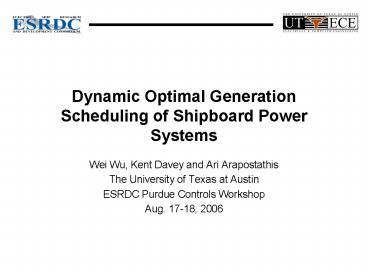Dynamic Optimal Generation Scheduling of Shipboard Power Systems
1 / 15
Title:
Dynamic Optimal Generation Scheduling of Shipboard Power Systems
Description:
The optimization problem is non-convex. Static Scheduling [Davey 2004] Power demand for speed vk ... system design based on dynamic scheduling (power storage! ... –
Number of Views:232
Avg rating:3.0/5.0
Title: Dynamic Optimal Generation Scheduling of Shipboard Power Systems
1
Dynamic Optimal Generation Scheduling of
Shipboard Power Systems
- Wei Wu, Kent Davey and Ari Arapostathis
- The University of Texas at Austin
- ESRDC Purdue Controls Workshop
- Aug. 17-18, 2006
2
Schematic of Power Train of Electric Ship
3
Motivation
- Turbine-generator design and control
- Key for power density and efficiency
- Design of Turbine-generator
- Granularity number, size, maximum power capacity
- Fuel how much is needed for different missions?
- Storage how much power storage is beneficial to
have in a warship? - Dynamic scheduling of turbine-generator
- Status ON or OFF
- Generation scheduling how much each generator
generates? - Storage control how to use the storage
dynamically
4
Specific Fuel Consumption
- Efficiency of power generator
- Maximum power is efficient for power generation
- Choice of the set of generators
- Max power 80MW destroyer
- Mission profile
- Fuel efficiency
5
Mission Profiles
- Mission profile Distribution of speed and power
for specific mission - ?k the probability at speed vk
- Mission profile alone is not sufficient for
controls - Frequency how fast the power demand changes?
- Switching cost of turbine-generator from OFF to
ON - Mission profile ? Load profile
6
Static Scheduling Formulation Fuel Consumption
Minimization
- Objective minimizing the total fuel consumption
- The optimization problem is non-convex
- Static Scheduling Davey 2004
Fuel consumed by Generator n at speed vk
Power demand for speed vk
7
Dynamic vs. Static Scheduling
- Static Scheduling suboptimal
- Generation scheduling depends only on power
demands - Switching fuel consumption fuel to restart
generators - Impact of power storage
- Dynamic scheduling
- Depends on power demands, generator status,
storage level - Capture performance impact by the intensity of
load fluctuations of the ship - Dimensioning the power storage
8
Dynamic Generation Scheduling Modeling (I)
- Speed transition S Markov chain, state s
- Transition probability parameterized by ?,
denoting the intensity of load fluctuations - Power demand P(s) at speed state s
- Generator state G how many generators are ON
Typical power profile for a navy frigate Max
Power 72MW, Hotel Power8 MW
9
Objective function Approximation
- Assumption convexized fuel consumption rate
- Nonconvex optimization
- Use a convex approximating function to model fuel
consumption rate
10
Modeling without Power Storage
- Model Markov decision process (MDP)
- State space (sn an-1) ? S G
- Action space (an Pn,s) ? G P
- Cost function power generation fuel switching
fuel - Transition probability
- Optimal policy dynamic programming equation
- Algorithm value iteration
11
Numerical Results (I)
- As intensity of load fluctuations increases, the
additional fuel consumption increases - The mission profile is not enough to design
control the turbine-generators - Max additional fuel 2.8 or 40 m3
420MW turbine-generators (4LM2500)
12
Numerical Results (II)
- Max additional fuel 10 or 135 m3
- Save 200 m3 fuel in comparison with 4LM2500
- Need to optimize the system design based on
dynamic scheduling (power storage!) - Adaptive control for intensity of load
fluctuations?
6 13.5 MW turbine-generators (6 13.5 MW
Alstom)
13
Preliminary Result (I) Modeling with Power
Storage
xn
d(s)
Turbine-generators
Switch Logic
- A queueing model
- Server power demand, Markov chain controlled
- Arrival generators, control the number of
generator - Queue power in storage
- Objective minimize fuel consumption
- Difference from the queueing model
- Storage leakage (e.g., flywheel) xn1?xn, ?lt1
14
Preliminary Result (II) Modeling with Power
Storage
- Model still MDP, but with constraints
- State space (xn sn an-1) ? XSG
- Action space (an Pn,s) ? GP
- Constraint xn ? 0
- System dynamics xn1 ?xnP-d(s)
- Optimal policy characterized by
Hamilton-Jocobi-Bellman equation - Solution
- Much higher computational complexity due to the
continuous variable xn - More intuitive results need to be further
explored
15
Conclusion and Future Work
- Address the question of dynamic power generation
- Control data need refined mission profiles
- Static scheduling is conservative
- Dynamic generation scheduling
- Symmetric turbine generators
- Long-time average cost
- Account for fuel penalty for generator startup
- Future work
- Structure results for scheduling with power
storage - Designing an algorithm to find the optimal
combinations of turbine-generators for given ship
configuration and missions































